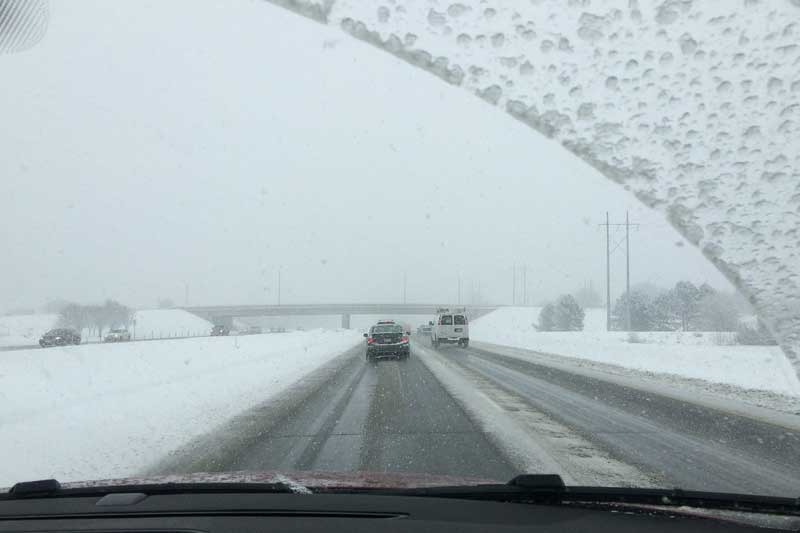Avoid a Crash: Texas Winter Weather Tips

It’s hard to imagine treacherous driving conditions in Texas with the climate typically ranging in the high 50s and low 60s during the winter months. But Texas does get hazardous winter weather from time to time. For example, heavy snowstorms commonly span the panhandle, according to the National Weather Forecast Office. Snowstorms are not as likely to occur in the South Plains, but you just never know. In fact, on Christmas Eve in 2004, a strong storm system moving across the Mexican Plateau produced a foot of snow in Victoria, Texas!
This year, El Nino will play a significant role in unusual weather events throughout the United States. Thus, South Texas, the Gulf Coast, and parts of West Texas will likely experience colder temperatures than usual and higher precipitation from December into late February 2016, the Weather Channel reports. North Texas, on the other hand, will experience a drier winter and near to above normal temperatures, according to Meteorologist Chris Coleman of the Electric Reliability Council of Texas.
Regardless of predictions and forecasting, if there is a chance of extreme winter weather conditions, such as sleet or snow, your local National Weather Service Office will issue an advisory, watch, or warning. A winter weather advisory means there is a minimal amount of wintry weather and that it isn’t likely to impact life or property. Should there be a winter weather storm watch, then this means you can expect to see harsher winter weather conditions within the next 36 hours. A warning means that wintry conditions will occur within the next 12 hours.
Because extreme winter weather conditions do not occur very often in Texas, it can be scary (and difficult) driving in a wintry mix when they do occur. Below are some practical driving tips to help you stay safe on the roads during the winter months in Texas.
Tips for Driving in Texas Winter Weather:
- Slow Down – It’s crucial to reduce your speed in extreme weather. The Texas Department of Transportation suggests traveling below the normal speed limit during winter weather. Slowing down is your #1 best way to remain safe and in control of your vehicle during extreme conditions.
- Watch for Black Ice – When it’s raining and the temperature drops, there’s a good chance the rain collecting on the roadways will become ice and appear black on the asphalt. Be extra cautious on ramps, bridges, overpasses, and shady areas where black ice tends to form first.
- Use Your Brakes Wisely on Icy Roads – The best way to handle braking in winter conditions depends on what type of braking system your vehicle has. With antilock braking systems (ABS), it is often best to slam on the brakes (thus engaging the ABS system) in order to remain in control of your vehicle for as long as possible and then use the steering wheel to maneuver around any possible obstacles. With traditional braking systems, if you feel your vehicle sliding on a patch of ice, let up on the gas pedal, do not slam on the brakes, and turn your steering wheel slightly in the direction you want it to go until you can regain traction. If you do not have ABS, braking (and overcorrecting with the steering wheel) will often cause your vehicle to spin more out of control. Of course, if the icy conditions are bad enough, no braking system will allow you to avoid sliding, which is why it is so important to reduce your speed.
- Be Equipped – Keep an emergency kit in your vehicle that includes a gallon of water, extra food, a cell phone, a flashlight, instant hand warmers, an ice scraper, a can of de-icing spray, a blanket, a bag of sand, a shovel, flares, and any other necessary supplies in case you get stuck and help can’t get to you in a short time.
- Pull Off the Road – If you encounter heavy rains, sleet, or fog, it can be difficult to see clearly. Find the safest spot to pull over and put on your hazard lights until visibility is better for driving.
- Allow for More Time – With bad weather, be sure to leave earlier than usual. Conditions could result in delays not only because it is more difficult to drive, but also because of accidents or plow trucks clearing snow off the roads and slowing traffic.
- Keep Your Distance – Keep an adequate distance between your vehicle and others’. In optimal conditions, it is prudent to keep at least two car lengths between you and the next driver, but in winter weather, the Texas DOT recommends that it be three times that distance. In addition, the DOT advises staying about 200 feet behind a snow-removal truck if you are following it.
As prepared as you might be, car accidents inevitably occur in winter weather. If you or someone you know has been injured in a motor vehicle crash, call Hossley & Embry at (866) 522-9265 and let us put our skill and experience to work for you. We offer free consultations so you can get honest advice about your best course of action after a car accident.
References:
Climate winters – Texas. (2015). U.S. Climate Data. Retrieved from:
http://www.usclimatedata.com/climate/winters/texas/united-states/ustx1482
Coleman, C. (n.d.). Seasonal updates. ERCOT. Retrieved from:
http://www.ercot.com/about/weather/updates.html
El Nino sets the stage for 2015-2016 winter weather. (2015, October 15). National Oceanic and Atmospheric Administration. Retrieved from: http://www.noaanews.noaa.gov/stories2015/101515-noaa-strong-el-nino-sets-the-stage-for-2015-2016-winter-weather.html
Lam, L. (2015, September). Winter 2015-16 outlook: Colder south and east coast, warmer north. The Weather Channel. Retrieved from: http://www.weather.com/forecast/national/news/winter-2015-2016-temperature-forecast-december-january-february
Long-range weather forecast for Texas-Oklahoma. (2015). The Old Farmer’s Almanac. Retrieved from: http://www.almanac.com/weather/longrange/region/us/11
Winter travel. (2015). Texas Department of Transportation. Retrieved from: http://www.txdot.gov/driver/weather/winter-travel.html
Winter weather climatology. (2015). National Weather Service Weather Forecast Office, Lubbock, TX. Retrieved from: http://www.srh.noaa.gov/lub/?n=wwad-coldestintexas







